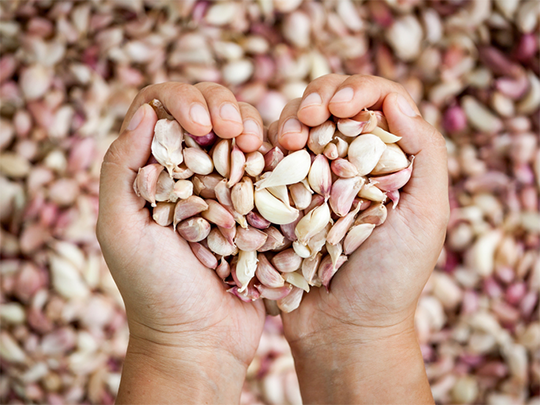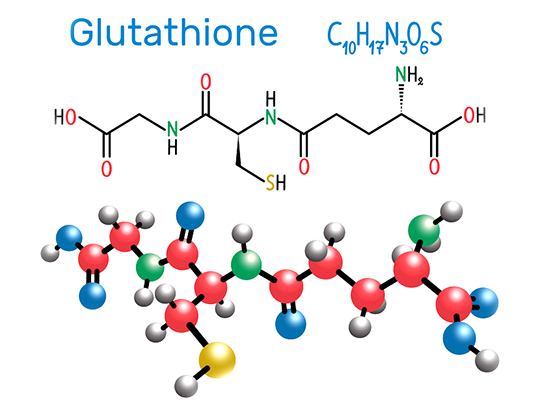Garlic, the “voodoo bulb” – love it or hate it (part 3)
Mostly, all good things are 3 – here comes the next blog part of our journey through garlic, the famous herb. The list of its beneficial effects is long - let´s have a look on two important activities of Allium sativum…
So far – and looking back at our first and second blog post on garlic – you already know a lot about the history of Allium sativum and its valuable ingredients. Let’s expand this knowledge with some beneficial effects of this fabulous herb…Do you know the antimicrobial and antioxidative effects of garlic?
Fields of application
Over the last decade, garlic has been investigated extensively for health benefits, as evident from many peer-reviewed scientific publications. Accordingly, garlic is considered as a plant with antibiotic, anticancer, anti-oxidant, immunomodulatory, anti-inflammatory, hypoglycemic and cardiovascular-protecting effects. Studies with birds and livestock reported that powdered garlic in a dose range on 0.25 to 0.50% improves growth and feed conversion ratio.
Antimicrobial activity

The antimicrobial qualities of crushed garlic, mainly arising from organosulfur compounds, have been known for many years. Phenolic compounds have demonstrated to contribute to antimicrobial properties.
In particular allicin and its sulfur compounds have germicidal properties in that they can act against all kinds of pathogenic microorganisms and parasites, without killing beneficial intestinal bacteria. Though at this point, it is fair to say that some investigations showed that certain strains of bifidobacteria where more susceptible to garlic´s antibacterial activity than others. Reported modes of action of garlic against pathogens is mostly based on modifications to secondary structure proteins, fatty acids and phospholipids in the cell membrane as well as nucleic acids. These changes may prevent exposed bifidobacteria from colonizing the intestines thus preventing them to fully exploit their beneficial potential.
Indeed, an approach, that should not be underestimated, as the intestinal microbiota makes up the largest part of the immune system, and therefore should be strengthened best possible. An intact intestinal environment also enables better absorption and utilization of nutrients, i.e. more building blocks reach the cells. This is mainly desired and applied in many sectors of livestock production, where improved nutrient availability benefits the entire organism and therefore enhances performance. Now you know about the antimicrobial effects of garlic – let’s have a look on the antioxidative effects.
Anti-oxidant activity

Garlic is also said to be able to inhibit cell damage thanks to its anti-oxidant secondary plant substances. Anti-oxidants inactivate reactive oxygen species (ROS) in the organism, the excessive presence of which leads to oxidative stress associated with aging and the development of a number of diseases. ROS naturally occur as byproduct of oxygen metabolism and as such they perform important roles (i.e. cell signaling, homeostasis). Environmental stress (i.e. heat stress and weaning) may lead to a laps of ROS levels, making them increase dramatically. For its protection, the organism, respectively the cells, confront the ROS or other toxic free radicals with anti-oxidant defense mechanisms. Plant derived phytochemicals, including garlic, provide additional protection against damage caused by oxidation processes.
Protein oxidation, DNA damage and lipid peroxidation count among the consequences of high-grade oxidative stress and are regarded as contributory causes to the ageing process. The latter, lipid peroxidation, ultimately leads to cells having to use more energy to stabilize their membrane potential. Upon low-density lipoproteins (LDL, lipoproteins that transport lipids in the blood) it comes to oxidative modifications that lead to atherosclerosis via the formation of foam cells. These foam cells are ‘transformed macrophages’, characterized by a massive accumulation of lipid droplets in the cytoplasm, which is seen as key process in the development of atherosclerosis. When foam cells become apoptotic, they release extracellular lipid droplets in the layer of endothelial cells coating the blood and lymph vessels.

According to a study, aged garlic extract inhibits lipid peroxidation and modification of LDL, thereby protecting endothelial cells from the injury caused by oxidized molecules. Other studies showed that garlic (raw and boiled) improved plasma lipid metabolism and plasma anti-oxidant activity in rats. Dietary garlic effectively reduced oxidative stress, which was shown by increased anti-oxidant activity and decreased blood lipids of rats. In both, in vivo and in vitro trials, boiled garlic, respectively its extract, turned out to be strong anti-oxidant. This was explained by enhanced lipid and anti-oxidant metabolic indices in the rat serum.
Garlic and its components can improve endogenous cellular anti-oxidant defenses: Glutathione (GSH) is present in almost every cell and is formed in the liver from glutamic acid, glycine and cysteine. It serves as substrate for glutathione peroxidase (GPX) and in its reduced form, it is able to mitigate free radicals. Therefore, it supports the immune system like hardly any other element in the body. Specific enzymes like superoxide dismutase (SOD), which dismutates reactive superoxides and catalase (CAT), which destroys toxic peroxides, also count among the important anti-oxidant defense mechanisms of cells. Bovine cell culture studies showed aged garlic extracts being able to protect endothelial cells from ROS by generating increased levels of SOD, CAT and GPX20.
Do you want the entire article as PDF including all references?

You are only one click away.
We still owe you the answer to why vampires hate this precious herb.

Elisabeth Rohrer
After her study in agriculture sciences at the university of natural resources and life sciences in Vienna, Elisabeth joined the Delacon team in December 2013 as Technical Communications Manager - a position, she always exerted with pleasure. Since 2021, her task areas have been extended and thus, she is also supporting colleagues in writing offside the technical focus as Content Manager. Elisabeth describes herself as a great animal and nature lover and prefers to spend her free time high up in the mountains with her little family, away from the hustle and bustle.










